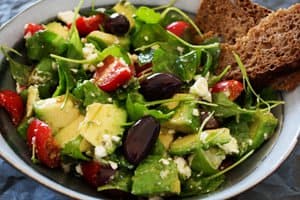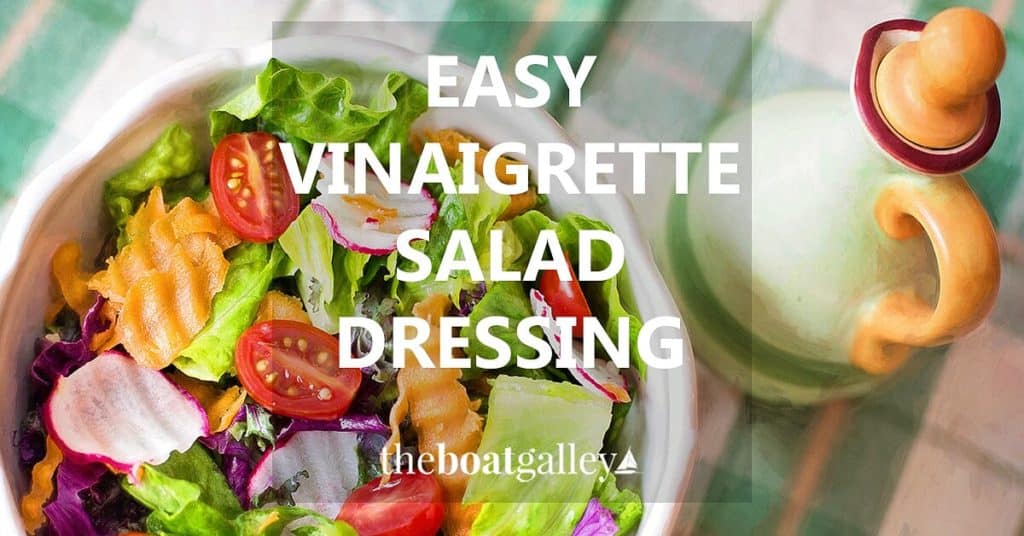If you’ve always used bottled salad dressings, it can be a rude shock to discover they’re not always easily available where you might be cruising.
Luckily, it’s easy to make your own from ingredients that you probably already have on board. This is one that my mom taught me to make, literally, when I was about 4 years old — it’s that simple!
I use this dressing for almost everything — lettuce salad, rice salad, green been salad and even pasta salad, tuna salad and cole slaw when I don’t want a mayonnaise-based dressing.
Additionally, none of the ingredients have to be refrigerated — a huge advantage if you don’t have a refrigerator — or a tiny one. Plus, the “recipe” (I almost hate to call it that) is easily scalable for any number of people.

Carolyn’s Easy Vinaigrette
Ingredients
- 1/2 tablespoon olive oil (or canola oil, vegetable oil or flavored oil) per serving
- 1/8 teaspoon salt per serving
- 1/2 teaspoon sugar (or sweetener) per serving
- 2 tablespoons vinegar (any type – balsamic, wine, rice, cider, white, flavored, etc.) per serving
Instructions
- Put all salad ingredients in bowl large enough to toss the salad in.
- Pour 1/2 tablespoon oil per serving over the salad.
- Quickly toss the salad just to partially coat everything with oil.
- Sprinkle salt and 1/2 teaspoon sugar (or sweetener) per serving over the top. Now drizzle 1 to 2 tablespoons vinegar over the top and toss again.
- Serve immediately.
Notes
- You can vary the proportions based on your own preferences — this is far less “oily” than a true French vinaigrette – and lower calorie. A “true” French vinaigrette uses about 3 parts oil to 1 part vinegar.
- The amount of vinegar varies by whether the salad will “soak up” the dressing – pasta and rice will, but lettuce or tuna won’t.
- You can add cheese or spices (basil, oregano, thyme are all good) for even more variations.
- Cider vinegar will give the sharpest taste, while the other vinegars are more mellow.

Carolyn Shearlock has lived aboard full-time for 17 years, splitting her time between a Tayana 37 monohull and a Gemini 105 catamaran. She’s cruised over 14,000 miles, from Pacific Mexico and Central America to Florida and the Bahamas, gaining firsthand experience with the joys and challenges of life on the water.
Through The Boat Galley, Carolyn has helped thousands of people explore, prepare for, and enjoy life afloat. She shares her expertise as an instructor at Cruisers University, in leading boating publications, and through her bestselling book, The Boat Galley Cookbook. She is passionate about helping others embark on their liveaboard journey—making life on the water simpler, safer, and more enjoyable.
Simplify meal prep on board with proven strategies for provisioning, maximizing fridge space, and cooking delicious meals aboard your boat.










Candy Ann Williams on Facebook says
I am a vinegar fan! We don’t ever use bottled dressings any more.
Frank says
Have you tried reversing the oil/vinegar additions?
Oil covers the salad and doesn’t allow the vinegar to penetrate so you just get the ‘bite’ of the vinegar. Since it’s an acid (similar to what’s in your stomach), If you put the vinegar on first, it actually starts to “pre-digest” the salad. It doesn’t change the mouth-feel or crispness of the salad (unless you leave it on for a half hour or so before adding the oil) but does reduce the aftereffects of things like cabbage.
Dave Skolnick (S/V Auspicious) says
Salad dressings are a great way to change things up and provide some diversity in salads (as long as the lettuce and the cabbage hold up). There are so very many choices with all the same ingredients, as Carolyn says, that we carry anyway. It’s worth noting that the raw ingredients to make things from scratch often last much longer than the finished product, so stocking up on eggs, vinegar, oil, UHT milk, and spices will give you lots of options at lower cost than buying prepared products. Make your own mayo (easy) and you are on track to homemade Russian dressing. Some spices and a little UHT cream (a la Mini Moos) and you have everything you need for Italian dressing (which is also a good marinade for poultry).
I do have to admit to still using an old Good Seasonings mixing bottle for homemade dressings to keep in the refrigerator. I’m way past the pre-mix packets but the dressing bottle is very convenient and helpful.
Debra Perfitt says
This is the best! Use it all the time. ???
David Brodhecker says
When making a vinaigrette please use a hand blender! It emulsifies the oil and vinegar which keeps the oil from making your greens go limp.
Martha says
It’s hard to find the canned roast beef. !! Any suggestions?
Carolyn Shearlock says
I’ve always been able to find it in the same area of the store as cans of tuna, hash, chicken and so on.
Donna says
Reminds me of a favorite dressing from Wiodloch Pines!
Patricia L. McMullen says
I love making my own dressing an quite often make it as I prep my salad. Usually only a single serving to take with me to work, takes two seconds!
Shangri La says
❤️ love this recipe
Cori Grant says
I too make my own dressing that keeps w/o refrigeration but I can’t wait to try yours and commit it to memory!
Nica Waters says
To me one of the very best first “make it yourself” things for reluctant, unconfident cooks.
The Boat Galley says
I think I learned my basic recipe when I was maybe 4. Definitely pre-school. It’s a great first thing!
Allan Cobb says
You can mix vinegars too such as cider and a dash of balsamic.
Gena Olson says
For all the ingredients except for the vinegar you said per serving. For the vinegar that one is that one to two tablespoons per serving also?
Carolyn Shearlock says
Yes 😎
JoAnn Williams says
I sometimes throw in a bit of oregano, too.